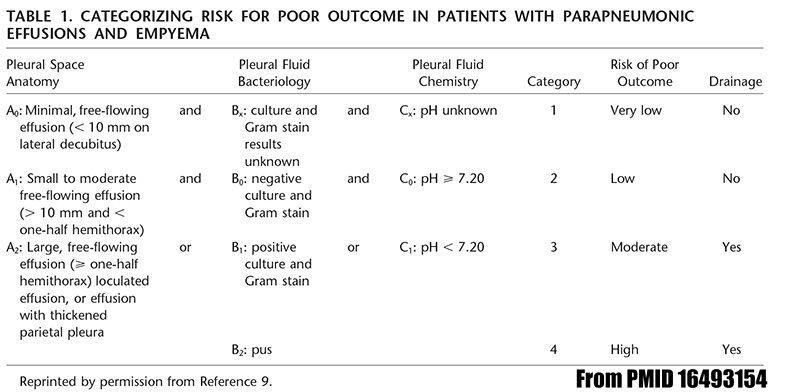Answer: Empyema
Initial concern was for pulmonary abscess. Subsequent CT scan showed pneumonia with empyema. Culture showed gram positive cocci and gram negative rods. Pt was started on zyvox and rocephin. He then had the empyema drained in the OR. Nearly 2 liters of frank pus was removed from the chest.
- A parapneumonic effusion is an effusion associated with a pneumonia, and up to 20-40% of patients hospitalized with pneumonia have a parapneumonic effusion.1
- Mortality rate in pneumonia is 3.7x higher in hospitalized patients with a parapneumonic effusion.1
- A complicated paramnemonic effusion is one where an invasive procedure is required to resolve the
 disease (such as a chest tube), if the gram stain shows bacteria, or if the pH is <7.2.1 An empyema is defined by a pulmonary effusion that has frank pus.1 A pulmonary abscess is defined as necrosis of the lung parenchyma as a result of microbial infection.2
disease (such as a chest tube), if the gram stain shows bacteria, or if the pH is <7.2.1 An empyema is defined by a pulmonary effusion that has frank pus.1 A pulmonary abscess is defined as necrosis of the lung parenchyma as a result of microbial infection.2 - The treatment of a parapneumonic effusion and empyema can be seen in table 1.1
- There are multiple sonographic findings described to evaluate an empyema or a lung abscess. These include evaluating wall characteristics, split pleura sign, internal echogenicity and color Doppler.3
- The most accurate way of differentiating empyema from an abscess is the identification of color Doppler ultrasound vessel signals in pericavitary lesions. Since a lung abscess is surrounded by lung, blood flow within the lung surrounding the abscess should be visible on ultrasound. This has been shown to be 94% sensitive and 100% specific for abscess. In contrast, an empyema is a pleural based lesion, and generally is not surrounded by blood flow.3

Jacob Avila, MD, RDMS
- Light RW. Parapneumonic effusions and empyema. Proc Am Thorac Soc. 2006;3(1):75-80.
- Chen HJ, Yu YH, Tu CY, et al. Ultrasound in peripheral pulmonary air-fluid lesions. Color Doppler imaging as an aid in differentiating empyema and abscess. Chest. 2009;135(6):1426-32.
- Desai H, Agrawal A. Pulmonary emergencies: pneumonia, acute respiratory distress syndrome, lung abscess, and empyema. Med Clin North Am. 2012;96(6):1127-48.


